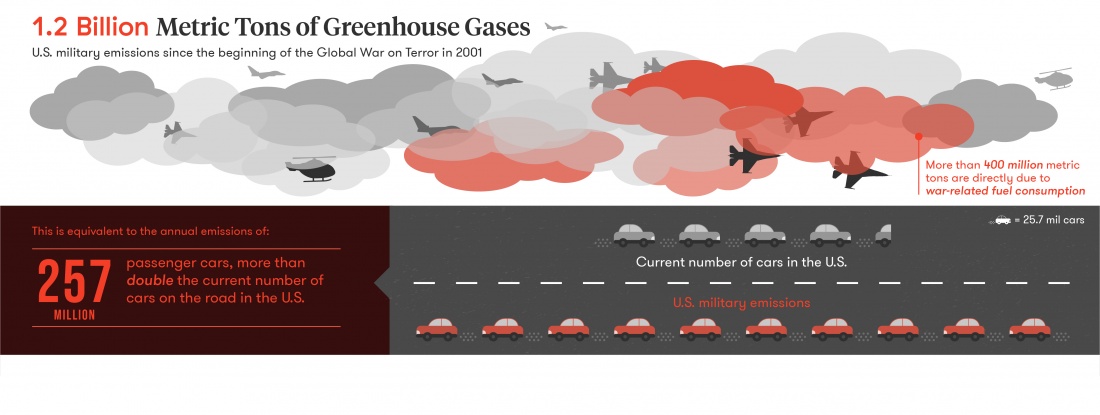
ACTION: Organizational Support for Bill
To Require Full Disclosure of DoD’s GHG
Veterans for Peace
(October 4, 2021) — The Veterans For Peace Climate Crisis and Militarism Project requests organizational endorsements of Rep. Barbara Lee’s (D-CA-13) resolution — Recognizing the Duty of the Department of Defense to Annually Report All Greenhouse Gas Emissions and Progress on Reduction Targets.
ACTION: Submit your organizational endorsement here.
RESOLUTION:
Recognizing the Duty of the Department of Defense
To Annually Report All Greenhouse Gas Emissions
And Progress on Reduction Targets
Whereas, in January 2021, United States Secretary of Defense Lloyd Austin stated the Defense Department “will immediately take appropriate policy actions to prioritize climate change considerations in our activities and risk assessments, to mitigate this driver of insecurity;”1
Whereas, Secretary Austin further stated, “[B]y changing how we approach our own carbon footprint, the Department can also be a platform for positive change, spurring the development of climate-friendly technologies at scale… It is a national security issue, and we must treat it as such;” 1
Whereas the Intergovernmental Panel on Climate Change report “Climate Change 2021” states human-induced climate change is already affecting many weather and climate extremes in every region across the globe; 2
Whereas the October 2018 report entitled ‘‘Special Report on Global Warming of 1.5oC’’ by the Intergovernmental Panel on Climate Change and the November 2018 Fourth National Climate Assessment report found that —
(1) global warming at or above 2 degrees Celsius beyond pre-industrialized levels will cause
(A) an increase in the number of people both exposed to climate-related risks and susceptible to poverty by up to several hundred million by 2050; 3
(B) the potential for losses in some sectors of the United States could reach hundreds of billions of dollars per year by the end of this century; 4
(C) more than 350,000,000 more people to be exposed globally to deadly heat stress by 2050; 3
(D) risk of damage to $1 trillion of public infrastructure and coastal real estate in the United States; 4 and
(2) to keep global temperatures below 1.5 degrees Celsius above pre-industrialized levels, which are necessary to avoid the most severe impacts of a changing climate, requires3—
(A) global reductions in greenhouse gas emissions from human sources of 45 percent from 2010 levels by 2030; and
(B) net-zero global emissions by 2050;

Whereas, Department of Defense does not publicly and regularly report its overall fuel consumption or greenhouse gas emissions and there is no official publicly available Department of Defense source for all military greenhouse gas emisions;5
Whereas; estimated overall greenhouse gas emissions of the United States military currently relies on publicly available emissions data from the Department of Energy;
Whereas; the Department of Defense does not release petroleum fuel consumption data and most US government accounting of United States greenhouse gas emissions omit figures on how much the military and the military industry contributes to United States emissions beyond domestic facilities and installations; 5
Whereas; the United States Undersecretary of State Stuart Eizenstat testified in 1997, “At Kyoto, the parties . . . took a decision to exempt key overseas military activities from any emissions targets” Consequently, excluding United States oversea military bases; 6
Whereas, the United States military emits more CO2 than over 120 separate countries, and would rank forty-seventh out of 170 if measured as a separate country; 7
Whereas, the Department of Energy reports that Department of Defense produced an average of about 66 million metric tons of CO2 equivalent per year in the period 2010 to 2018, roughly the same greenhouse gas emissions as 14 million passenger cars driven for one year, or roughly equivalent to the greenhouse gas emissions of the residential sector of the United States; 5
Whereas, emissions from United States industries producing defense materiel averaged 153 million metric tons of CO2 each year for the period from 2001 to 2017; 5
Whereas, Vice President Kamala Harris stated “One country’s carbon emissions can threaten the sustainability of the whole earth” in her 2021 commencement address to the United States Naval Academy; 8
Whereas, NATO’s June 14, 2021 communique states it “will develop a mapping methodology to help Allies measure greenhouse gas emissions from military activities and installations, which could contribute to formulating voluntary goals to reduce such emissions;” 9
Whereas the House of Representatives recognizes that as “one country’s carbon emissions can threaten the sustainability of the whole earth…,” the emissions of the globe’s largest institutional source of greenhouse gas emissions, the Department of Defense, must be monitored and reduced; Now, therefore, be it
Resolved, That it is the sense of the House of Representatives that-
(1) It is the duty of the Department of Defense to reduce the overall environmental impact of all military activities and missions;
(2) It is the duty of the Department of Defense to monitor, track and report greenhouse gas emissions from all of its operations, including but not limited to combat operations, deployments, drone attacks, weapons production and testing, base construction and functions;
(3) It is the duty of the Department of Defense to set clear annual greenhouse gas emission reduction targets for both domestic and foreign activities that are consistent with the 1.5oC target specified by the 2015 Paris Agreement;
(4) It is the duty of the Department of Defense to commit to annual greenhouse gas emission reporting mechanisms that are robust, comparable and transparent, are based on recognized greenhouse gas monitoring protocols, and which are independently verified and include emissions from domestic and overseas United States military bases, from their contractors, and from the manufacture and transport of military equipment and weapons;
(5) It is the duty of the Department of Defense to define clear greenhouse gas reduction targets for its military technology contractors and to report their full greenhouse gas emission;
(6) It is the duty of the Department of Defense to prioritize greenhouse gas reduction initiatives at source and only utilize verifiable offsets of greenhouse gas emissions;
(7) It is the duty of the Department of Defense to publish greenhouse gas reduction policies, strategies and action plans, with annual follow-up reporting on performance from all its operations;
(8) It is the duty of the Department of Defense to evaluate how reducing military expenditure and deployments, and altering military postures can reduce emissions;
(9) It is the duty of the Department of Defense to demonstrate leadership, openness and a willingness to collaborate and exchange information on good practices with non-military stakeholders;
(10) The Department of Defense should repurpose and manage its properties to promote carbon sequestration and biodiversity;
(11) The Department of Defense should commit to increase climate and environmental training for decision makers, including how it can mitigate climate change and environmental degradation;
(12) The Department of Defense should incorporate climate and environmental assessments in decision-making for all procurement, activities and missions; and
(13) The Department of Defense should commit to allocating the appropriate resources to ensure all climate and environmental protection policies can be fully implemented.